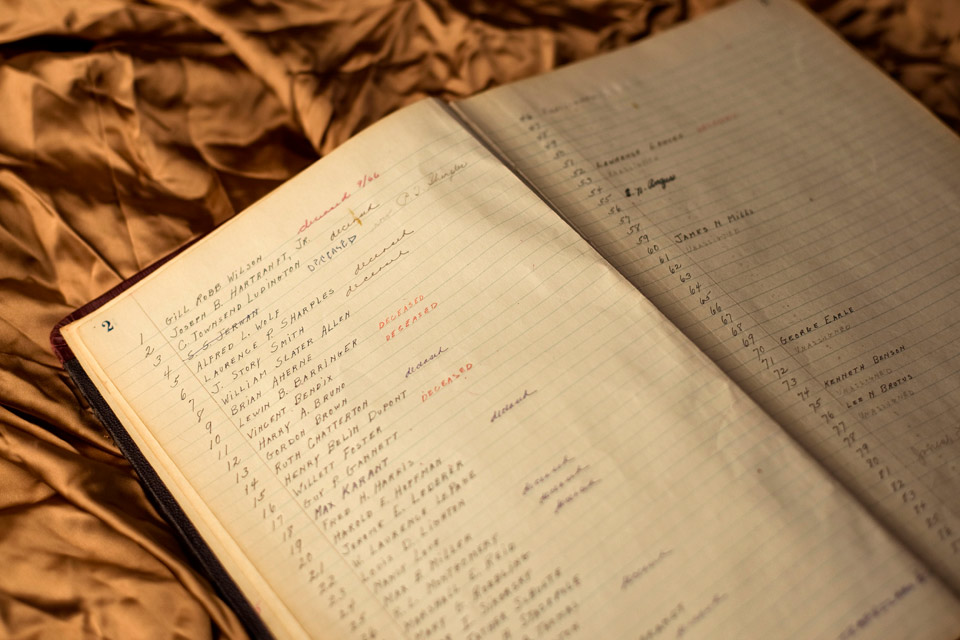 Seventy-five years after its founding in May 1939, a dozen charter members remain active on AOPA’s membership rolls. On the occasion of the association’s diamond anniversary, we talk with three of them—one helped AOPA secure its first office, in Chicago; another was nicknamed the “baby student” because he was the youngest pilot at his airport; the third used general aviation to build his business—about AOPA and their flying over the years. Longer versions of these interviews can be found on AOPA Online.
Seventy-five years after its founding in May 1939, a dozen charter members remain active on AOPA’s membership rolls. On the occasion of the association’s diamond anniversary, we talk with three of them—one helped AOPA secure its first office, in Chicago; another was nicknamed the “baby student” because he was the youngest pilot at his airport; the third used general aviation to build his business—about AOPA and their flying over the years. Longer versions of these interviews can be found on AOPA Online.
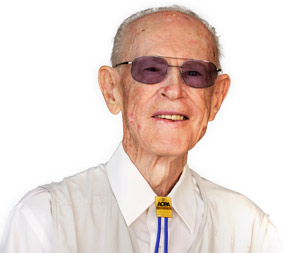 Seeing the light
Seeing the light
Student’s idea launches pilot into lighting business
Bill Bailey was interested in aviation from the time he was six years old. “Every night when I went to bed, I was praying to the good Lord that he would let me be a good pilot,” recalls Bailey, 94, of Genesee, Michigan.
His flight instructor sold 10 hours of dual instruction in a Taylorcraft for $50. “That was enough to solo.” Bailey soloed—and joined AOPA—in May 1939. “They ran an ad in the flying magazine, telling about the AOPA, and I thought that sounded good. I’ve been a member ever since.”
Bailey wasn’t particularly concerned about the buildup to what would become World War II. He bought a straight-wing Waco biplane from an airport manager who had flown the mail with Charles Lindbergh. A barnstormer, complete with the baggy pants, checked him out. “We walk out to the plane and he says, ‘It’s been a while; I better take it around myself.’ I don’t think he’d ever been in a Waco. [Then] I take a ride around the field with him and then he crawls out and gets in the front and I get in the back. I give it the throttle and away we go. I’m not really in control of things yet, but we come around and I didn’t make too bad a landing—and he’s crawling out. He said, ‘Oh, you can fly this thing.’ I gave it the throttle and away we go—that’s how I got checked out in that Waco biplane.”
After Pearl Harbor, Bailey sold the Waco for $425—the amount he had paid for it—and joined the Army. Initially classified as a mechanic, he eventually became a Curtiss P–40 pilot, assigned as a gunnery instructor. He later transitioned to the P–47, but combat ended before he could be sent overseas.
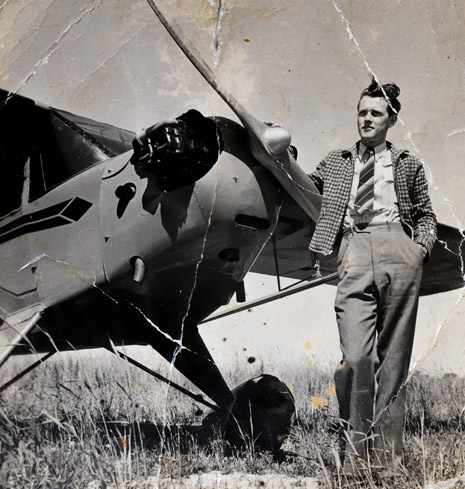 Following the war he obtained his flight instructor certificate. In January 1947, one of his students had the idea of putting a fluorescent light on a service-station hoist, so the mechanic could do a grease job—required on cars in those days—without having to hold a flashlight in addition to the grease gun and a rag. That launched Bailey into the lighting business. “At one time we had 100 employees, and two plants, and my son is still running the business today—67 years after I started it.”
Following the war he obtained his flight instructor certificate. In January 1947, one of his students had the idea of putting a fluorescent light on a service-station hoist, so the mechanic could do a grease job—required on cars in those days—without having to hold a flashlight in addition to the grease gun and a rag. That launched Bailey into the lighting business. “At one time we had 100 employees, and two plants, and my son is still running the business today—67 years after I started it.”
Bailey flew a flying club’s Aztecs and Bonanzas, then bought a Bonanza of his own—flying to solve many business problems and make sales calls, as well as personal trips to Florida and to several AOPA conventions, including Palm Springs, California. “I was looking for a Stearman, but I ran into this Starduster that was built for about 180 horsepower—this fellow put in a 310 [-horsepower turbocharged engine]. That was a full job to fly that thing. But that was a great, fun airplane. You could do anything—go almost straight up with it!”
He sold both airplanes in 2007. “I was 87 years old and I had some cancer operations, and so I decided it was time to hang ’em up.” He had logged more than 2,000 hours—and flown even more—“over 67 years of wonderful flying. If I hadn’t had physical problems, I’d probably be trying to fly yet.”
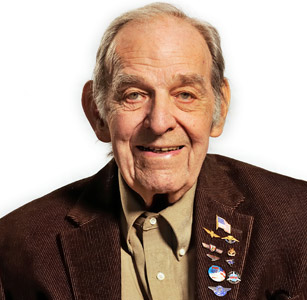 A fortuitous youth
A fortuitous youth
Serendipitous childhood fosters lifetime in aviation
Clarence A. “Clancy” Hess earned his nickname as a pilot in the Marine Corps during World War II. “I managed to leave a bomb in a Japanese ship that had a big boom [crane]. There was a popular song back in those days, Clancy, Lower the Boom—they saw the ship capsize and the boom went in the water, so that’s been my nickname ever since.”
Hess, 92, of Lockport, Illinois, grew up on a farm near Skokie, Illinois. His neighbor was Louie Meyer, the race car driver. “He bought one of the first Waco 9s. Starting in 1928, he was taking me for airplane rides with him, out of their pasture, so early on I figured out what a stick and rudder bar did in an airplane.”
When the National Air Races came to Chicago in 1930, Hess’s father—a carpenter—helped build the wooden grandstands at Curtiss-Reynolds Airport, which later became Glenview Naval Air Station. The top race pilots of the day, Art Chester from Joliet, Illinois, and Johnny Livingston from Waterloo, Iowa, arrived and prepared to camp under their wings. “My dad saw heavy weather coming in and invited them to come to our house, because the house I grew up in was outfitted so people harvesting the crops could stay overnight—there was bunk space for 16 people. When they arrived, I can still remember how pleased they were.”
The races lasted 10 days, and some of those pilots stayed the whole time at the Hess residence. Jimmy Doolittle and Charles Lindbergh also visited. “It’s why I got so tangled up” in aviation, Hess recalled.
 On Hess’s tenth birthday, Livingston showed up for breakfast, then took Hess flying in his Velie Monocoupe. “He kept asking me questions or telling me stuff about what airplanes were about, and later my dad told me I interrupted him a few times because I already knew that stuff. He put me up in the left seat. He says, ‘Well, you’ve been telling me stuff about airplanes, now show me!’” Hess taxied around for a while, then they flew circuits for an hour and 45 minutes. “Then he got out and said, ‘Go fly it, kid,’ so I am as far as I can determine the first to be soloed on my tenth birthday.”
On Hess’s tenth birthday, Livingston showed up for breakfast, then took Hess flying in his Velie Monocoupe. “He kept asking me questions or telling me stuff about what airplanes were about, and later my dad told me I interrupted him a few times because I already knew that stuff. He put me up in the left seat. He says, ‘Well, you’ve been telling me stuff about airplanes, now show me!’” Hess taxied around for a while, then they flew circuits for an hour and 45 minutes. “Then he got out and said, ‘Go fly it, kid,’ so I am as far as I can determine the first to be soloed on my tenth birthday.”
Hess worked for the FBO at what is now Chicago Midway International Airport, and for lunch he often had a bowl of chili at the terminal lunch counter. One day a man sat down beside him and asked if the chili was good. “He introduced himself. He had just arrived and his name was Doc Hartranft.” AOPA had been founded in Philadelphia the week before, and Hartranft had come to Chicago to find an office. Hess helped him secure one that afternoon. “I had cousins who worked in the Transportation Building. The first address for AOPA was simply Transportation Building, Chicago, Illinois.”
Hess also met Arthur Collins, who started Collins Radio; Reuben Fleet, the owner of Consolidated Aircraft; Bill Lear; and others—and had more than 1,000 hours of flight time—before joining the Marines, where he served as a photographer as well as a TBF Avenger pilot. Twice he spent an entire day in the ocean, once after a midair collision and again after his engine was hit. He and a friend gained notoriety in December 1944, when they flew 700 miles to Townsville, Australia, to procure beer, rum, and cigars for the officer’s club on Bougainville, in the Solomon Islands.
After World War II, Hess met the chief pilot for American Airlines at the Midway lunch counter, and went to work for the airline the following Monday. In Korea he flew the R4Q, the Marine Corps’ version of the Fairchild C–119 Flying Boxcar. For the rest of his 32 years with American, he was involved in research and design, working with the Corporate Projects Group.
Hess founded Wings of Hope with four other airline pilots, initially providing a Piper Super Cub to a Catholic nun and pilot from Ireland. Wings of Hope originally operated from Lewis University Airport.
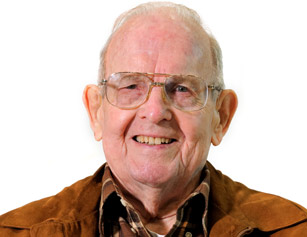 The ‘baby student’
The ‘baby student’
Airport’s youngest pilot leverages GA’s utility
Seventy-five years ago Ed Adams, 92, of Winston-Salem, North Carolina, was the “baby student” of Stewart Airport in Parkersburg, West Virginia. He joined AOPA primarily to associate with other pilots. “I’ve had a passion for flying ever since I was very, very young,” he said. “I was 17 years old, and had just soloed. When I graduated from high school my father gave me flying lessons at the local airport. I soloed in seven days.”
He garnered the moniker because he was the youngest student on the field. “The newspaper gave [me] the heading of ‘baby student,’” said Adams, who still has a scrapbook filled with yellowed newspaper clippings from the local paper, which gave flight training and local aviation events considerable coverage.
Most of his training was in Piper Cubs, then he moved on to a Waco. “The Waco F was the most fun to fly—I really enjoyed that. [Aerobatics] help improve your flying, and improve precision flying.” The young aviator hoped to attend the Boeing School of Aeronautics and become an airline pilot. “The war interrupted that,” said Adams, whose eyesight ultimately precluded a career as an airline—or military—pilot.
“After the war, I came back and started flying privately again. I had a Cessna 172, and then a Bonanza, and then I went to the Baron. I was in the ceramic tile business and I used the Baron to make trips all over the United States, to call on customers and so forth.”
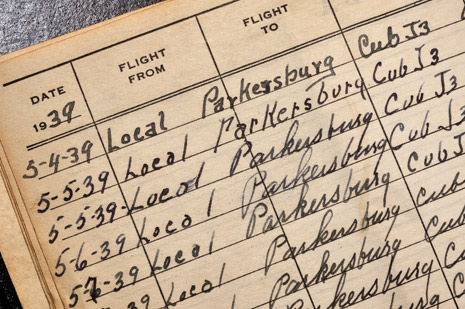 Around 1980, Adams flew from Owensboro-Daviess County (Kentucky) Airport to St. John’s, Newfoundland, Canada—in one day. “We had a mine located in Newfoundland, and it was quite an experience to make that trip. I remember flying across 180 miles of water to get to Newfoundland and I guess I was lonely, all by myself out there, and I called Canadian air traffic control and the first thing they said to me was, ‘Are you lonely?’ They said, ‘We have you on radar, you’re right on course, and you’ll be in Newfoundland in another 20 minutes.’”
Around 1980, Adams flew from Owensboro-Daviess County (Kentucky) Airport to St. John’s, Newfoundland, Canada—in one day. “We had a mine located in Newfoundland, and it was quite an experience to make that trip. I remember flying across 180 miles of water to get to Newfoundland and I guess I was lonely, all by myself out there, and I called Canadian air traffic control and the first thing they said to me was, ‘Are you lonely?’ They said, ‘We have you on radar, you’re right on course, and you’ll be in Newfoundland in another 20 minutes.’”
For eight years he served on the Owensboro-Daviess County Airport Board. “When I was the chairman, we found it necessary to hire legal help in Washington, and I had no knowledge of anybody in Washington. I called AOPA and they gave me names of attorneys that we should contact, and that helped us immensely.” Later, he was appointed to the Kentucky Air Zoning Commission.
When Adams joined AOPA there was no AOPA Pilot, although there was an insert in Popular Aviation, which later became Flying. “I’ve always read it, and I still do today, every page of the magazine. I consider it as continuing education. And even though I’m not flying today, I still read it,” he said. “There’s so much to be learned.”
He logged 7,000 to 8,000 hours, most of it on business and personal trips in the Barons he owned. Adams stopped flying in 1986, partially because of concerns that he might have a heart attack—although that never happened. “It took an awful lot of thought; I didn’t want to do it, and I still wish I could go out and fly tomorrow.”
Video: Video interview with three charter members.
Photography by the author and Chris Rose
Email [email protected]



